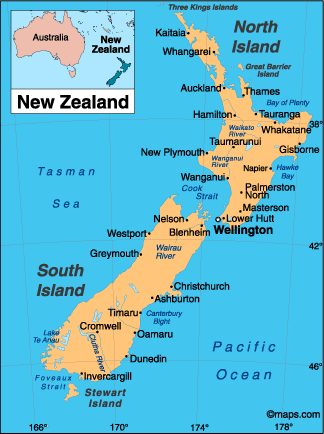NEW ZEALAND

Geography: New Zealand, about 1,250 mi (2,012 km) southeast of Australia, consists of two main islands and a number of smaller outlying islands so scattered that they range from the tropical to the antarctic. The country is the size of Colorado. New Zealand's two main components are the North Island and the South Island, separated by Cook Strait. The North Island (44,281 sq mi; 115,777 sq km) is 515 mi (829 km) long and volcanic in its south-central part. This area contains many hot springs and beautiful geysers. South Island (58,093 sq mi; 151,215 sq km) has the Southern Alps along its west coast, with Mount Cook (12,316 ft; 3754 m) the highest point. Other inhabited islands include Stewart Island, the Chatham Islands, and Great Barrier Island. The largest of the uninhabited outlying islands are the Auckland Islands (234 sq mi; 606 sq km), Campbell Island (44 sq mi; 114 sq km), the Antipodes Islands (24 sq mi; 62 sq km), and the Kermadec Islands (13 sq mi; 34 sq km).
Government: Parliamentary democracy.
History: Maoris were the first inhabitants of New Zealand, arriving on the islands in about 1000. Maori oral history maintains that the Maoris came to the island in seven canoes from other parts of Polynesia. In 1642, New Zealand was explored by Abel Tasman, a Dutch navigator. British captain James Cook made three voyages to the islands, beginning in 1769. Britain formally annexed the islands in 1840.
The Treaty of Waitangi (Feb. 6, 1840) between the British and several Maori tribes promised to protect Maori land if the Maoris recognized British rule. Encroachment by British settlers was relentless, however, and skirmishes between the two groups intensified.
Government: Parliamentary democracy.
History: Maoris were the first inhabitants of New Zealand, arriving on the islands in about 1000. Maori oral history maintains that the Maoris came to the island in seven canoes from other parts of Polynesia. In 1642, New Zealand was explored by Abel Tasman, a Dutch navigator. British captain James Cook made three voyages to the islands, beginning in 1769. Britain formally annexed the islands in 1840.
The Treaty of Waitangi (Feb. 6, 1840) between the British and several Maori tribes promised to protect Maori land if the Maoris recognized British rule. Encroachment by British settlers was relentless, however, and skirmishes between the two groups intensified.

Map of New
Zealand
Sovereign: Queen Elizabeth II
(1952)
Governor-General: Sir Jerry Mateparae
(2011)
Prime Minister: John Key
(2008)
Land area: 103,734 sq mi (268,671 sq km);
total area: 103,737 sq mi (268,680 sq km)
Population (2014 est.): 4,401,916
(growth rate: 0.83%); birth rate: 13.4/1000; infant mortality rate:
4.59/1000; life expectancy: 80.93
Capital (2011 est.):
Wellington, 410,000
Largest cities: Auckland, 1.452 million
Monetary unit: New Zealand dollar
Languages:
English (de facto official) 89.8%, Maori (de jure
official) 3.5%, Samoan 2%, Hindi 1.6%, French 1.2%, Northern Chinese
1.2%, Yue 1%, Other or not stated 20.5%, New Zealand Sign Language (de
jure official)
Ethnicity/race:
European 71.2%, Maori 14.1%, Asian 11.3%, Pacific
peoples 7.6%, Middle Eastern, Latin American, African 1.1%, other 1.6%,
not stated or unidentified 5.4%
Religions:
Christian 44.3% (Catholic 11.6%, Anglican 10.8%,
Presbyterian and Congregational 7.8%, Methodist, 2.4%, Pentecostal 1.8%,
other 9.9%), Hindu 2.1%, Buddhist 1.4%, Maori Christian 1.3%, Islam
1.1%, other religion 1.4% (includes Judaism, Spiritualism and New Age
religions, Baha'i, Asian religions other than Buddhism), no religion
38.5%, not stated or unidentified 8.2%, objected to answering 4.1%
National Holiday:
Waitangi Day, February 6
Literacy rate: 99% (2003 est.)
Economic summary: GDP/PPP (2013
est.): $114.9 billion; per capita $30,400. Real growth rate:
2.5%. Inflation: 1.3%. Unemployment: 6.43%. Arable
land: 1.76%. Agriculture: wheat, barley, potatoes, pulses,
fruits, vegetables; wool, beef, lamb and mutton, dairy products;
fish. Labor force: 2.413 million: services 74%, industry 19%,
agriculture 7% (2006). Industries: food processing, wood and
paper products, textiles, machinery, transportation equipment,
banking and insurance, tourism, mining. Natural resources:
natural gas, iron ore, sand, coal, timber, hydropower, gold,
limestone. Exports: $37.84 billion (2013 est.): dairy
products, meat, wood and wood products, fish, machinery.
Imports: $37.35 billion (2013 est.): machinery and equipment,
vehicles and aircraft, petroleum, electronics, textiles, plastics.
Major trading partners: Australia, U.S., Japan, China,
Singapore, Germany (2006).
Member of Commonwealth of Nations
Communications: Telephones: main lines
in use: 1.88 million (2012); mobile cellular: 4.922 million (2012).
Broadcast media: state-owned Television New
Zealand operates multiple TV networks and state-owned Radio New Zealand
operates 3 radio networks and an external shortwave radio service to the
South Pacific region; a small number of national commercial TV and
radio stations and many regional commercial television and radio
stations are available; cable and satellite TV systems are available
(2008). Internet hosts: 3.026 million
(2012). Internet users: 3.4 million (2009).
Transportation: Railways: total: 4,128
km (2006). Roadways: total: 94,160 km; paved: 62,759 km
(includes 199 km of expressways); unpaved: 32,143 km (2012).
Waterways: 1,609 km; of little importance to transportation.
Ports and harbors: Auckland, Lyttelton, Manukau Harbor, Marsden Point, Tauranga, Wellington. Airports: 123 (2013).
International disputes: territorial
claim in Antarctica (Ross Dependency).
-------------------- o --------------------
No comments:
Post a Comment